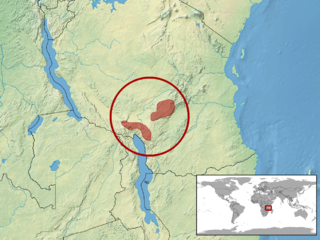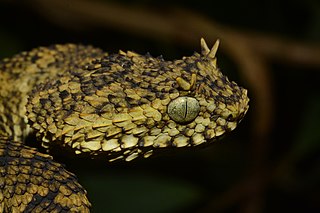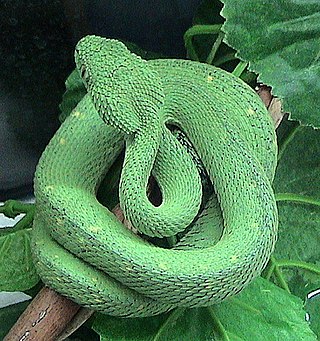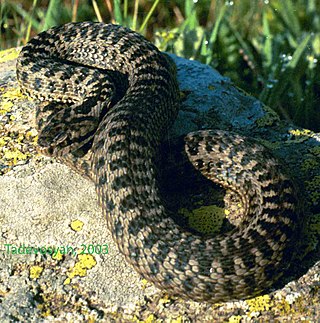
The Viperinae, or viperines, are a subfamily of vipers endemic to Europe, Asia and Africa. They are distinguished by their lack of the heat-sensing pit organs that characterize their sister group, the subfamily Crotalinae. Currently, 13 genera are recognized. Most are tropical and subtropical, although one species, Vipera berus, even occurs within the Arctic Circle. Like all vipers, they are venomous.

Trimeresurus is a genus of venomous pit vipers found in Asia from the Indian Subcontinent throughout Southeast Asia, China, and the Pacific Islands. Currently 44 species are recognized. Common names include Asian palm pit vipers, Asian lanceheads, and green pit vipers.

Craspedocephalus strigatus, commonly known as the horseshoe pit viper, is a species of venomous snake in the subfamily Crotalinae of the family Viperidae. The species is endemic to the Western Ghats of India. There are no subspecies that are recognized as being valid.

Atheris squamigera is a venomous viper species endemic to west and central Africa. No subspecies are currently recognized.

Atheris is a genus of vipers known as bush vipers. They are found only in tropical subsaharan Africa and many species have isolated and fragmented distributions due to their confinement to rain forests. Like all other vipers, they are venomous. In an example of convergent evolution, they show many similarities to the arboreal pit vipers of Asia and South America. Seventeen species are currently recognized.

Protobothrops sieversorum, commonly known as the three horned-scaled pitviper or the three-horn-scaled pit-viper, is a species of venomous snake, a pit viper in the family Viperidae. The species is endemic to Vietnam.

Echis is a genus of vipers found in the dry regions of Africa, the Middle East, India, Sri Lanka and Pakistan. They have a characteristic threat display, rubbing sections of their body together to produce a "sizzling" warning sound. The name Echis is the Latin transliteration of the Greek word for "viper" (ἔχις). Like all vipers, they are venomous. Their common name is "saw-scaled vipers" and they include some of the species responsible for causing the most snakebite cases and deaths in the world. Twelve species are currently recognized.

Atheris barbouri is a small and rare species of terrestrial viper endemic to the Uzungwe and Ukinga mountains of south-central Tanzania in Africa.
Montatheris is a monotypic genus created for the viper species, Montatheris hindii, which also known by the common names Kenya mountain viper, Kenya montane viper, montane viper, and Hind's viper. Like all other vipers, M. Hindii is venomous. This is a small terrestrial species endemic to Kenya. There are no subspecies which are currently recognized as being valid.

Atheris ceratophora is a venomous viper species endemic to a few mountain ranges in Tanzania. This used to be the only horned, arboreal viper known from Africa, until the discovery in 2011 of Atheris matildae, also found in Tanzania. No subspecies are currently recognized.

Atheris chlorechis is a viper species found only in the forests of West Africa. No subspecies are currently recognized. It is the type species of its genus. It is venomous.
Atheris katangensis, also known as the Katanga Mountain bush viper and other common names, is a species of venomous viper found in the eastern Democratic Republic of the Congo and in Zambia. No subspecies are currently recognized.

Atheris nitschei is a species of venomous snake, a viper in the subfamily Viperinae of the family Viperidae. The species is native to Africa. There are no subspecies that are recognized as being valid.

Vipera darevskii, known as Darevsky's viper, is a small species of viper, a venomous snake in the subfamily Viperinae of the family Viperidae. The species is native to northwestern Armenia, northeastern Turkey, and possibly also adjacent southern Georgia. There are no subspecies that are recognized as being valid.

The Persian horned viper, known as the Persian horned viper, false horned viper, and by other common names, is a species of vipers endemic to the Middle East and Asia. Like all other vipers, it is venomous.
Protobothrops kaulbacki, commonly known as the Kaulback's lance-headed pitviper or Kaulback's lance-headed pit viper, is a venomous pit viper species endemic to Asia. No subspecies are currently recognized.
Trimeresurus gracilis, commonly known as the Taiwan pit viper or Taiwan mountain pitviper, is a venomous pit viper species endemic to Taiwan. No subspecies are currently recognized. The species is known as kikushi habu in Japanese.
Garthius chaseni, commonly known as Chasen's mountain pit viper, Chasen's tree viper, and the Kinabalu brown pit viper, is a species of venomous pitviper in the family Viperidae. The species is endemic to the island of Borneo in Malaysia. No subspecies are currently recognized. It is monotypic in the genus Garthius.
Gloydius strauchi is a species of venomous pit viper in the subfamily Crotalinae of the family Viperidae. The species is native to western China. It is a small snake with a pattern of four longitudinal stripes, although some older specimens may be a uniform black. G. strauchi may be distinguished from G. monticola by its higher midbody dorsal scale count. This species jointly holds the altitude record for pitvipers together with Crotalus triseriatus of Mexico, both being found even above the tree line at over 4,000 m (13,000 ft). No subspecies were recognized as being valid, until a recent publication re-evaluated the taxonomic statuses of populations of G. strauchi and described the eastern Tibetan populations as a new species.

Bothrops jonathani, known commonly as Jonathan's lancehead or the Cochabamba lancehead, is a species of venomous snake, a pit viper in the family Viperidae. The species is endemic to South America.














